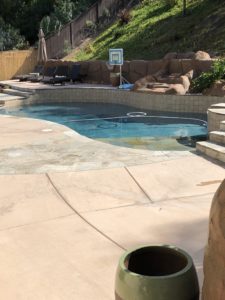If Water Chemistry is Off, Your Salt Cell Will Struggle
My salt chlorinator isn’t working again and it’s becoming a common problem! If you are trying to troubleshoot the problem, we can promise you that you aren’t alone. Lots of homeowners purchased salt chlorinators for their swimming pools because they were sold on the fact that they were maintenance free, they were fairly easy to use and that your swim experience would be much better. We would agree with the quality of water and the feel of the water part, but they definitely aren’t maintenance free and they do require work especially when it comes to having a balanced water chemistry. At Weber Pools, we get a lot of phone calls and inquiries on this issue and if we can help fix it. The following are the most common reasons why we see them not working:
- Not enough salt or too much salt
- Lack of Cyanuric Acid (CYA)
- The size of the chlorinator isn’t big enough for your swimming pool
- Too much calcium in the water causing scaling on the electrode plates
First and foremost, we highly recommend performing a thorough water analysis to make sure your chemistry is where it needs to be for your salt chlorinator. This would be the easiest to fix and usually the least expensive. We highly recommend checking the following levels:
- pH – the salt will cause it to rise
- CYA
- Calcium Hardness – needs to be between 200-400ppm for most systems
- Salt levels
If any of the above are out of balance it can cause malfunction with your salt chlorinator. Please refer to the owner’s manual in regard to water chemistry because each salt chlorinator manufacturer has different requirements for their system. If the salt, CYA or pH is out of balance those are easy fixes but if your Calcium Hardness (CH) is too high that causes other issues and is typically a much harder fix. In the Dallas area, the tap water is hard. Since our calcium comes out of the tap at 300ppm and with water that high in hardness, the calcium will scale the electrode plates and prevent them from operating. At this point a water change is necessary and we would like to highlight a customer whose salt chlorinator wasn’t working. He chose to use our Reverse Osmosis (RO) mobile filtration because we have the ability to give you much better water than tap.
When we arrived at this residence we measured their initial chemistry
Calcium Hardness – 900ppm (too high for their system)
Total Dissolved Solids – 7202ppm
Salt – 4762ppm (slightly high for their system)
CYA – 100ppm
After filtering this 20,000-gallon swimming pool for 16 hours we were able to lower their levels to the following:
Calcium Hardness – 130ppm
Total Dissolved Solids – 824ppm
Salt – 624ppm
CYA – 0ppm
Upon completion and addition of adequate salt and conditioner, their salt system started working great. In conclusion, we recommend a water change every 1-2 years, especially with salt systems. To learn more about this operation and how we can help you, contact us today!

